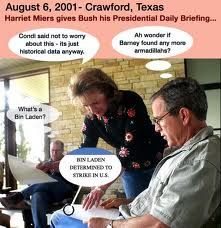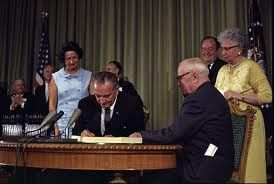This is your morning Open Thread. Pour your favorite beverage and review the past and comment on the future.
Find the past “On This Day in History” here.
Click on images to enlarge
August 6 is the 218th day of the year (219th in leap years) in the Gregorian calendar. There are 147 days remaining until the end of the year.
 On this day there have been many significant events. Certainly, one of the most memorable is that this is the anniversary of dropping of the first atomic bomb on Hiroshima, Japan. It is also the anniversary of President Johnson signing the Voting Rights Act.
On this day there have been many significant events. Certainly, one of the most memorable is that this is the anniversary of dropping of the first atomic bomb on Hiroshima, Japan. It is also the anniversary of President Johnson signing the Voting Rights Act.
Recent significant history that has been over looked by my usual sources is this: The August 6, 2001 Presidential Daily Briefing better known as the August 6th PDB. It was handed to President George W. Bush, who was on one of his many vacations to his home in Crawford, TX, by Harriet Miers, who was the President’s WH Council, and promptly ignored. Whether Bush ignored the warning that Osama bin Laden was planning to attack the US because he was told to let it happen or, the darker theory, that the government made it happen will never be known, at least not in the lifetime of those reading this. Whatever Bush’s motive was, it set off a series of events in this country that has affected us all and divided us like no other incident since the Civil War. The US has now been in Afghanistan for almost 9 years 10 years 12 years and Iraq for over seven eight , the last U.S. combat troops withdrawing from Iraq on 18 December, 2011. Despite campaign promises to restore the rule of law and the Constitution, the Obama administration has continued the most heinous of the Bush policies that are violations of not just US law but International Law, ratified treaties and agreements. A sad anniversary, indeed.
I wrote this three years ago, although Pres. Obama has withdrawn combats troops from Iraq, “support” troops still remain. The US is in the process drawing down military presence in Afghanistan. That may sound encouraging but the President has since increased drones attacks in Pakistan and targeted American citizens for assassination and, now, is turning the US into a police surveillance state, shredding the Constitutional rights of its citizens. So much for ending the “war on terror” and restoring the rule of law.

 Television, rock and roll and teenagers. In the late 1950s, when television and rock and roll were new and when the biggest generation in American history was just about to enter its teens, it took a bit of originality to see the potential power in this now-obvious combination. The man who saw that potential more clearly than any other was a 26-year-old native of upstate New York named
Television, rock and roll and teenagers. In the late 1950s, when television and rock and roll were new and when the biggest generation in American history was just about to enter its teens, it took a bit of originality to see the potential power in this now-obvious combination. The man who saw that potential more clearly than any other was a 26-year-old native of upstate New York named 
 The USS Nautilus was constructed under the direction of U.S. Navy Captain Hyman G. Rickover, a brilliant Russian-born engineer who joined the U.S. atomic program in 1946. In 1947, he was put in charge of the navy’s nuclear-propulsion program and began work on an atomic submarine. Regarded as a fanatic by his detractors, Rickover succeeded in developing and delivering the world’s first nuclear submarine years ahead of schedule. In 1952, the Nautilus’ keel was laid by President Harry S. Truman, and on January 21, 1954, first lady Mamie Eisenhower broke a bottle of champagne across its bow as it was launched into the Thames River at Groton, Connecticut. Commissioned on September 30, 1954, it first ran under nuclear power on the morning of January 17, 1955.
The USS Nautilus was constructed under the direction of U.S. Navy Captain Hyman G. Rickover, a brilliant Russian-born engineer who joined the U.S. atomic program in 1946. In 1947, he was put in charge of the navy’s nuclear-propulsion program and began work on an atomic submarine. Regarded as a fanatic by his detractors, Rickover succeeded in developing and delivering the world’s first nuclear submarine years ahead of schedule. In 1952, the Nautilus’ keel was laid by President Harry S. Truman, and on January 21, 1954, first lady Mamie Eisenhower broke a bottle of champagne across its bow as it was launched into the Thames River at Groton, Connecticut. Commissioned on September 30, 1954, it first ran under nuclear power on the morning of January 17, 1955.



